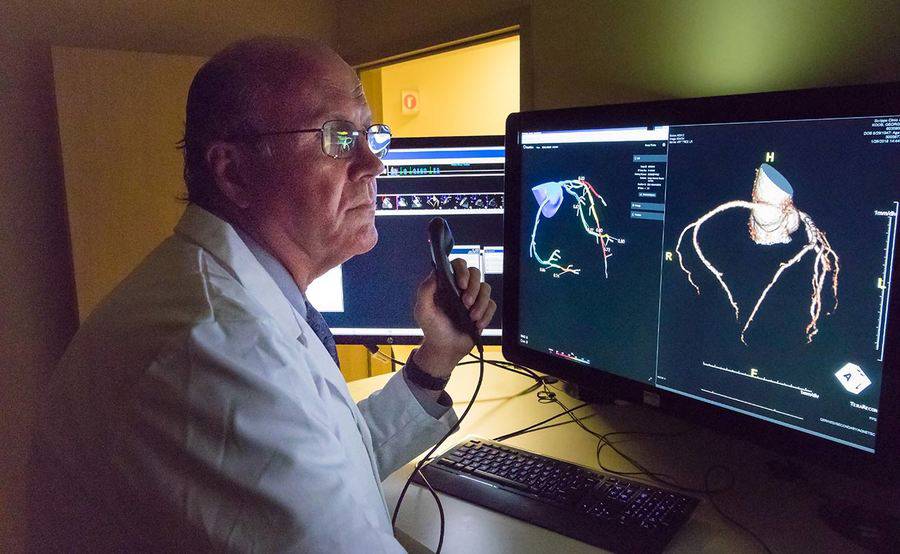Heart Tests and Heart Disease Diagnosis
Leading the way in cardiac imaging and diagnostics

Dr. George Wesbey III, Cardiology, Scripps Clinic
Leading the way in cardiac imaging and diagnostics
In our facilities throughout San Diego, radiologists, nurses, technicians and cardiologists work as a team. Scripps provides more cardiac imaging exams and diagnostic tests for heart disease than any other regional health care provider.
Scripps has advanced cardiovascular imaging, the latest diagnostic technologies and some of the nation’s leading physicians and specialists to diagnose and treat all heart conditions. Using the most advanced technology, we offer heart care services for you and your family throughout San Diego County — from Chula Vista to Oceanside — making our team of experts available where and when you need them.
Our approach to heart tests at Scripps
Determining the best course of treatment for a heart condition may begin with one or more diagnostic tests to understand how the heart is functioning. These heart tests can be performed in the office of a Scripps cardiologist or at our hospitals, clinics and outpatient imaging centers.
Scripps uses state-of-the-art screening technology to ensure patients receive a comprehensive evaluation to aid in medical diagnoses and developing an effective treatment plan. Diagnostic testing and procedures for the heart at Scripps include non-imaging tests, imaging and nuclear imaging.
Non-imaging heart tests
- Physical exam
- Blood tests, including those to measure glucose and lipids
- Electrocardiogram (also known as ECG or EKG)
- Electrocardiography stress test
- Ambulatory electrocardiography (also known as Holter monitor)
- Cardiac catheterization
- Electrophysiology study (also known as EPS)
- Head upright tilt test (also known as tilt table test)
- Myocardial biopsy
Cardiac imaging
Imaging of the heart is often central to collaboration among treatment teams before, during and after heart procedures and surgeries. For example, physicians at Scripps specializing in 3-D echocardiograms work real-time with surgeons during interventional procedures such as transcatheter aortic valve replacement (TAVR).
Scripps is a leader in training hospital heart teams on this leading-edge combination of structural cardiology intervention and imaging.
If you have signs or symptoms of a cardiovascular problem such as chest pain or tightness, an imaging exam may be part of your overall heart care. Imaging exams and procedures for the heart at Scripps include:
- Chest X-ray
- Heart computed tomography (CT) scan
- Heart magnetic resonance imaging (MRI) scan
- Magnetic resonance angiography (MRA)
- Heart fluoroscopy
- Vascular ultrasound (also known as duplex ultrasound)
- Intravascular ultrasound (also known as IVUS)
- 3-D echocardiogram
- HeartFlow FFR-CT analysis
- Stress echocardiogram
- Transesophageal echocardiogram (also known as TEE)
- Coronary angiography (also known as cardiac angiogram)
Nuclear cardiac imaging
Nuclear heart imaging exams involve using an injection of a small amount of safe, radioactive tracer into the bloodstream. For nuclear imaging of the cardiovascular system, the tracer is viewed with a gamma detector as it moves with the blood through the heart, creating computer-generated images. Nuclear imaging procedures for diagnosing heart conditions at Scripps may include:
- Blood volume test performed to measure the amount of blood in the body, as well as the volume of red blood cells and plasma
- Heart positron emission tomography (PET) scan that can determine if areas of heart muscle are getting enough blood
- Multigated acquisition scan (MUGA) to examine the pumping function of the ventricles (lower chambers of the heart)
- Nuclear exercise stress test that tracks and measures blood flow to the heart at rest and during and after exercising at a target heart rate on a treadmill or stationary bicycle
- Pharmacological nuclear stress test that tracks and measures blood flow to the heart at rest and after medication is provided to dilate vessels and increase the heart rate
- Hemodynamic test that evaluates the function of the heart and circulation and can help pinpoint the cause of circulation abnormalities such as syncope, a momentary loss of consciousness due to decreased blood flow to the brain